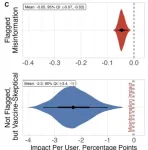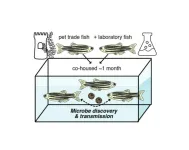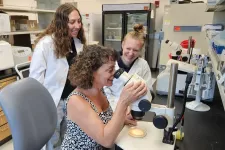(Press-News.org) CAMBRIDGE, Mass., May 30, 2024 – Since the rollout of the COVID-19 vaccine in 2021, fake news on social media has been widely blamed for low vaccine uptake in the United States — but research by MIT Sloan School of Management PhD candidate Jennifer Allen and Professor David Rand finds that the blame lies elsewhere.
In a new paper published in Science and co-authored by Duncan J. Watts of the University of Pennsylvania, the researchers introduce a new methodology for measuring social media content’s causal impact at scale. They show that misleading content from mainstream news sources — rather than outright misinformation or “fake news” — was the primary driver of vaccine hesitancy on Facebook.
A new approach to estimating impact
“Misinformation has been correlated with many societal challenges, but there’s not a lot of research showing that exposure to misinformation actually causes harm,” explained Allen.
During the COVID-19 pandemic, for example, the spread of misinformation related to the virus and vaccine received significant public attention. However, existing research has, for the most part, only established correlations between vaccine refusal and factors such as sharing misinformation online — and largely overlooked the role of “vaccine-skeptical” content, which was potentially misleading but not flagged as misinformation by Facebook fact-checkers.
To address that gap, the researchers first asked a key question: What would be necessary for misinformation or any other type of content to have far-reaching impacts?
“To change behavior at scale, content has to not only be persuasive enough to convince people not to get the vaccine, but also widely seen,” Allen said. “Potential harm results from the combination of persuasion and exposure.”
To quantify content’s persuasive ability, the researchers conducted randomized experiments in which they showed thousands of survey participants the headlines from 130 vaccine-related stories — including both mainstream content and known misinformation — and tested how those headlines impacted their intentions to get vaccinated against COVID-19. Researchers also asked a separate group of respondents to rate the headlines across various attributes, including plausibility and political leaning. One factor reliably predicted impacts on vaccination intentions: the extent to which a headline suggested that the vaccine was harmful to a person’s health.
Using the “wisdom of crowds” and natural language processing AI tools, Allen and her co-authors extrapolated those survey results to predict the persuasive power of all 13,206 vaccine-related URLs that were widely viewed on Facebook in the first three months of the vaccine rollout. By combining these predictions with data from Facebook showing the number of users who viewed each URL, the researchers could predict each headline’s overall impact — the number of people it might have persuaded not to get the vaccine. The results were surprising.
The underestimated power of exposure
Contrary to popular perceptions, the researchers estimated that vaccine-skeptical content reduced vaccination intentions 46 times more than misinformation flagged by fact-checkers.
The reason? Even though flagged misinformation was more harmful when seen, it had relatively low reach. In total, the vaccine-related headlines in the Facebook data set received 2.7 billion views — but content flagged as misinformation received just 0.3% of those views, and content from domains rated as low-credibility received 5.1%.
“Even though the outright false content reduced vaccination intentions the most when viewed, comparatively few people saw it,” explained Rand. “Essentially, that means there’s this class of gray-area content that is less harmful per exposure but is seen far more often —and thus more impactful overall — that has been largely overlooked by both academics and social media companies.”
Notably, several of the most impactful URLs within the data set were articles from mainstream sources that cast doubt on the vaccine’s safety. For instance, the most-viewed was an article — from a well-regarded mainstream news source — suggesting that a medical doctor died two weeks after receiving the COVID-19 vaccine. This single headline received 54.9 million views — more than six times the combined views of all flagged misinformation.
While the body of this article did acknowledge the uncertainty of the doctor’s cause of death, its “clickbait” headline was highly suggestive and implied that the vaccine was likely responsible. That’s significant since the vast majority of viewers on social media likely never click out to read past the headline.
How journalists and social media platforms can help
According to Rand, one implication of this work is that media outlets need to take more care with their headlines, even if that means they aren’t as attention-grabbing.
“When you are writing a headline, you should not just be asking yourself if it’s false or not,” he said. “You should be asking yourself if the headline is likely to cause inaccurate perceptions.”
For platforms, added Allen, the research also points to the need for more nuanced moderation — across all subjects, not just public health.
“Content moderation focuses on identifying the most egregiously false information — but that may not be an effective way of identifying the most overall harmful content,” she says. “Platforms should also prioritize reviewing content from the people or organizations with the largest numbers of followers while balancing freedom of expression. We need to invest in more research and creative solutions in this space – for example, crowdsourced moderation tools like X’s Community Notes.”
“Content moderation decisions can be really difficult because of the inherent tension between wanting to mitigate harm and allowing people to express themselves,” Rand said. “Our paper introduces a framework to help balance that trade-off by allowing tech companies to actually quantify potential harm.”
And the trade-offs could be large. An exploratory analysis by the authors found that if Facebook users hadn’t been exposed to this vaccine-skeptical content, as many as 3 million more Americans could have been vaccinated.
“We can’t just ignore this gray area-content,” Allen concluded. “Lives could have been saved.”
END
Misleading COVID-19 headlines from mainstream sources did more harm on Facebook than fake news
New MIT Sloan research shows that unflagged but misleading content on Facebook was less persuasive, but much more widely seen, and thus generated more COVID-19 vaccine skepticism than flagged misinformation.
2024-05-30
ELSE PRESS RELEASES FROM THIS DATE:
Historic iceberg surges offer insights on modern climate change
2024-05-30
(Santa Barbara, Calif.) — A great armada entered the North Atlantic, launched from the cold shores of North America. But rather than ships off to war, this force was a fleet of icebergs. And the havoc it wrought was to the ocean current itself.
This scene describes a Heinrich Event, or a period of rapid iceberg discharge from the Laurentide Ice Sheet during the last glacial maximum. These episodes greatly weakened the system of ocean currents that circulates water within the Atlantic Ocean. The Atlantic Meridional Overturning Circulation, or AMOC for short, brings warm surface water ...
Reexamining misinformation: How unflagged, factual content drives vaccine hesitancy
2024-05-30
What threatens public health more, a deliberately false Facebook post about tracking microchips in the COVID-19 vaccine that is flagged as misinformation, or an unflagged, factual article about the rare case of a young, healthy person who died after receiving the vaccine?
According to Duncan J. Watts, Stevens University Professor in Computer and Information Science at Penn Engineering and Director of the Computational Social Science (CSS) Lab, along with David G. Rand, Erwin H. Schell Professor at MIT Sloan School of Management, and Jennifer Allen, 2024 MIT Sloan School of Management Ph.D. graduate ...
Novel virus identified in zebrafish from the pet trade causes disease in laboratory fish
2024-05-30
Zebrafish in the pet trade are asymptomatic carriers of previously undescribed microbes, including a novel virus that causes hemorrhaging in infected laboratory fish, Marlen Rice from the University of Utah, US, and colleagues report in the open-access journal PLOS Biology, publishing May 23rd.
Zebrafish (Danio rerio) are a common laboratory research animal, and they are also widely available as pets. In research laboratories, they are kept in specialized aquaculture facilities to prevent infectious disease, but zebrafish are occasionally ...
Cuckoos evolve to look like their hosts - and form new species in the process
2024-05-30
The theory of coevolution says that when closely interacting species drive evolutionary changes in each other this can lead to speciation - the evolution of new species. But until now, real-world evidence for this has been scarce.
Now a team of researchers has found evidence that coevolution is linked to speciation by studying the evolutionary arms race between cuckoos and the host birds they exploit.
Bronze-cuckoos lay their eggs in the nests of small songbirds. Soon after the cuckoo chick hatches, it pushes the host’s eggs out of the nest. The host not only loses all its own eggs, but spends several ...
Cause of heart failure may differ for women and men
2024-05-30
A new study from the UC Davis School of Medicine found striking differences at the cellular level between male and female mice with heart failure with preserved ejection fraction (HFpEF).
The findings could determine how HFpEF is treated in women compared to men.
With HFpEF, the heart muscle contracts normally but the heart is unable to fully relax and refill properly between beats. This condition is known as diastolic dysfunction. It can occur if the heart is too stiff or if the contraction process doesn’t shut off quickly enough between ...
Tiny worm helps uncover long-lasting prenatal effects from amphetamines
2024-05-30
Amphetamine is a psychostimulant that has been used to treat a variety of brain dysfunctions. However, it is a highly abused drug. In fact, amphetamine and amphetamine-derived compounds such as methamphetamine (Meth) are among the most abused psychostimulants in the world.
The neurological effects caused by acute or chronic use of amphetamine have been broadly investigated and several studies have shown that proteins involved in the synthesis, storage, release and reuptake of dopamine (DA), a neurotransmitter that plays a role as in ...
Banners backfire: Misinformation impact on search results
2024-05-30
ITHACA, N.Y. – Cornell University researchers have found in a public health emergency, most people pick out and click on accurate information during internet searches.
Though higher-ranked results are clicked more often, they are not more trusted. And the presence of misinformation does not damage trust in accurate results that appear on the same page. However, banners at the top of the search results page warning about misinformation decrease trust in accurate information, according to the research published in Scientific Reports.
The relationship between ...
UC3M is a shareholder of five of its researchers’ new spin-offs
2024-05-30
The Universidad Carlos III de Madrid (UC3M) has become a shareholder of five new companies recently set up and promoted by different researchers: Applied Innovative Methods, Hiili, Persei Space, Seevia Technologies and 60Nd.
UC3M participates in the share capital of its spin-offs in order to contribute to their business development. This minority and temporary shareholding is articulated in accordance with the regulations for the creation of knowledge-based university companies.
AI Methods, S.L., led by Manuel Soler ...
New method makes hydrogen from solar power and agricultural waste
2024-05-30
University of Illinois Chicago engineers have helped design a new method to make hydrogen gas from water using only solar power and agricultural waste, such as manure or husks. The method reduces the energy needed to extract hydrogen from water by 600%, creating new opportunities for sustainable, climate-friendly chemical production.
Hydrogen-based fuels are one of the most promising sources of clean energy. But producing pure hydrogen gas is an energy-intensive process that often requires coal or natural gas and large amounts of electricity.
In a paper for Cell Reports Physical Science, a multi-institutional ...
Credibility makes or breaks the price: political commitment in long-term climate policy key for effective EU emissions trading system
2024-05-30
“The price on emitting carbon that is harmful to the climate has risen sharply in the past; basically, it roughly increased tenfold over the last five years and two policy reforms. Our analysis implies that besides directly changing the ETS rules, the reforms also increased the long-term credibility of the EU ETS and thereby made firms more farsighted, aligning their market behaviour with long-term climate targets,” explains Joanna Sitarz, PIK scientist and first author of the study published in Nature Energy. “In ...
LAST 30 PRESS RELEASES:
Scientists use ultrasound to soften and treat cancer tumors without damaging healthy tissue
Community swimming program for Black youth boosts skills, sense of belonging, study finds
Specific depressive symptoms in midlife linked to increased dementia risk
An ‘illuminating’ design sheds light on cholesterol
Who is more likely to get long COVID?
Study showcases resilience and rapid growth of “living rocks”
Naval Research Lab diver earns Office of Naval Research 2025 Sailor of the Year
New Mayo-led study establishes practical definition for rapidly progressive dementia
Fossil fuel industry’s “climate false solutions” reinforce its power and aggravate environmental injustice
Researchers reveal bias in a widely used measure of algorithm performance
Alcohol causes cancer. A study from IOCB Prague confirms damage to DNA and shows how cells defend against it
Hidden viruses in wastewater treatment may shape public health risks, study finds
Unlock the power of nature: how biomass can transform climate mitigation
Biochar reshapes hidden soil microbes that capture carbon dioxide in farmland
Reducing saturated fat intake shows mortality benefit, but only in high-risk individuals
Manta rays create mobile ecosystems, study finds
Study: Mixed results in using lipoic acid to treat progressive multiple sclerosis
Norbert Holtkamp appointed director of Fermi National Accelerator Laboratory
New agentic AI platform accelerates advanced optics design
Biologists discover neurons use physical signals — not electricity — to stabilize communication
Researchers discover that a hormone can access the brain by hitchhiking
University of Oklahoma researcher awarded funding to pursue AI-powered material design
Exploring how the visual system recovers following injury
Support for parents with infants at pediatric check-ups leads to better reading and math skills in elementary school
Kids’ behavioral health is a growing share of family health costs
Day & night: Cancer disrupts the brain’s natural rhythm
COVID-19 vaccination significantly reduces risk to pregnant women and baby
The role of vaccination in maternal and perinatal outcomes associated with COVID-19 in pregnancy
Mayo Clinic smartwatch system helps parents shorten and defuse children's severe tantrums early
Behavioral health spending spikes to 40% of all children’s health expenditures, nearly doubling in a decade
[Press-News.org] Misleading COVID-19 headlines from mainstream sources did more harm on Facebook than fake newsNew MIT Sloan research shows that unflagged but misleading content on Facebook was less persuasive, but much more widely seen, and thus generated more COVID-19 vaccine skepticism than flagged misinformation.






